Japan
Wood Products Prices
Dollar Exchange Rates of 10th
March
2021
Japan Yen 108.49
Reports From Japan
Circular economy initiative
launched
The Ministry of the Environment and the Japan Business
Federation (Keidanren) announced the launch of a
¡®Partnership on Circular Economy¡¯ at the March Circular
Economy Roundtable hosted by the World Economic
Forum. This aims to bring the private sector and
government together to advance the circular economy in
Japan. The partnership is expected to evolve through
collaboration with the World Economic Forum¡¯s Circular
Economy Initiative.
See:
https://www.env.go.jp/en/headline/2502.html
Small businesses suffering badly
Business sentiment among large Japanese companies in
the January-March period turned negative for the first time
in three quarters reflecting the impact of the country¡¯s
second state of emergency declared in early January.
The index for manufacturers stood at plus 11.6, down from
plus 21.6 in the previous quarter but remained positive for
the third three-month period. The index for nonmanufacturers
was minus 7.4, dropping from plus 6.7,
turning negative for the first time in three quarters.
See:
https://www.japantimes.co.jp/news/2021/03/12/business/economy-business/negative-business-sentiment/
The situation of smaller businesses was more serious
where the index fell to minus 31.4 from minus 15.5 for the
October-December period. The index for these companies
has been negative for 28 consecutive quarters.
Data from the Ministry of Finance showed companies in
Japan reduced spending on plant and equipment in the
final quarter of 2020, the third consecutive quarter posting
a decline. This has raised doubts on speed at which a
recovery can be achieved.
The data shows capital spending fell almost 5% in the last
quarter 2020 compared with the same period a year earlier
and this is despite a pick-up in exports to China and the
US and this is likely to result in weaker than forecast GDP
growth.
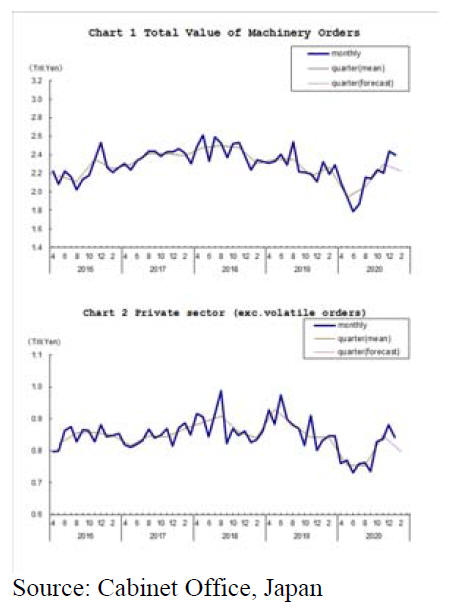
Decline in corona infections lifts consumer
sentiment
Japan's consumer confidence improved in February, the
second sharpest increase on record after the surge in June
2020 when the first state of emergency was lifted. The
Cabinet Office suggested that the main factor affecting
consumer sentiment was the steady decline in the number
of virus cases rather than whether or not the country has a
state of emergency (SoE) in effect.
The second SoE began 7 January for the Tokyo
metropolitan area and then expanded to 11 prefectures. It
has since been scaled back and now only covers the Tokyo
metropolitan region. The SoE was scheduled to end on 7
March but has been extended by two weeks amid concerns
about the recent slowing down in the decline of infections.
The Cabinet Office upgraded its assessment for the first
time in five months, saying consumer sentiment has
"remained in a severe situation but shown signs of
recovery." In January it said sentiment was "weakening."

Yen at 12 month low
At 108 plus yen to the US dollar the yen is at its lowest in
12 months. The driver of the almost 5% decline in the
yen/dollar exchange rate was the surge in US stocks after
the Chairperson of the US Federal Reserve dismissed
concerns that the bank¡¯s economic support increased the
risk of spiraling inflation and insisted that the ¡®easy¡¯
monetary policy would remain in place for sometime.
At a recent Senate Banking Committee meeting the Fed
chairperson said the economic recovery was ¡°uneven and
far from complete¡±.

Private sector forecast for 2021 housing
The Japan Forest Products Journal sent out questionnaires
to 14 major house builders to find out how they see new
housing starts in 2021.
Average number by 14 companies is 805,000 units, 1.3%
less than 2020 with high of 835,000 and low of 774,000.
Majority commented that it is hard to predict market future
as long as COVID-19 epidemic continues but it is apparent
that consumers are seeking new life style and the move is
improving. After all, it seems safe to forecast the same as
last year with foggy future.
Total starts in 2020 were 815,340 units, 9.9% less than
2019. Despite worldwide pandemic of COVID-19 in 2020,
damage to housing market is much less than initially
forecasted with 20-30 % drop from 2019. (For more see
page 13)
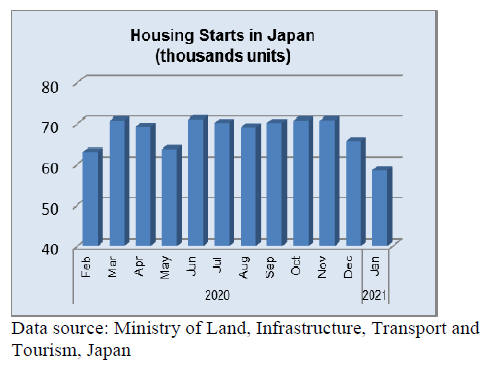
Import update
Wooden door Imports
2021 began with the two main suppliers of wooden doors,
China and the Philippines dominating imports but their
share of total wooden door imports fell to 75% from
around 80% in the previous months. Most of the lost share
went to shippers in SE Asia, notably Malaysia.
Year on year January 2021 wooden door imports
(HS441820) were down over 30% and compared to the
value of imports in December there was a 29% decline in
January. The impact of declining housing starts had a clear
impact on imports.
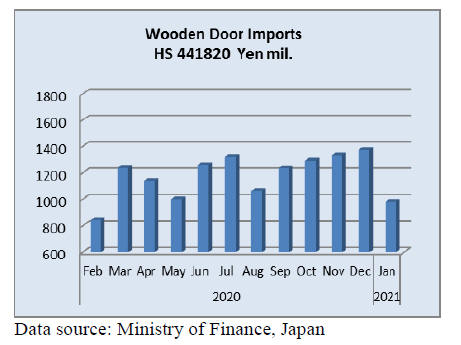
Wooden window imports
The value of January 2021 imports of wooden windows
(HS441810) fell almost 50% year on year and there was
an almost 30% decline in month on month imports. Three
shippers, China (41%), the US (15%) and the Philippines
(15%) accounted for most of Japan¡¯s wooden window
imports in January 2021 but all saw their share of imports
drop as a bigger share of imports was captured by shippers
in Sweden and South Korea.
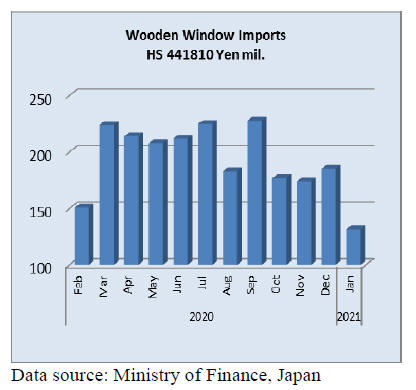
Assembled wooden flooring imports
HS441875 continued to dominate Japan¡¯s imports of assembled
flooring in January 2021 accounting for over 70% of the various
categories imported. Shippers in China accounted for over 60%
of January 2021 imports of assembled flooring followed by
Vietnam (12%). A further 10% was supplied from Malaysia and
Indonesia.
Year on year, Japan¡¯s imports of assembled wooden flooring
(HS441871-79) fell 38% but there was a 31% increase in imports
in January compared to a month earlier markig two consecutive
monthly increases.
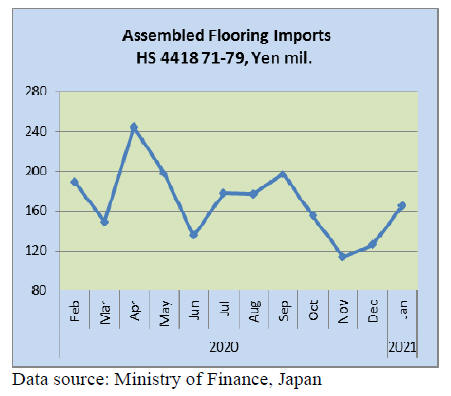
Plywood imports
The year started with a rise in the volume of plywood
imports and all of the main shippers, except China, saw
increases. Between them, Malasia and Indonsesia account
for most of Japan¡¯s imports of plywood and in January
shippers in these two countries accounted for over 80% of
all plywood (HS441210-39) imports.
The balance was supplied from Vietnam and China.
Throughout 2020 the volumes of plywood shipped from
Chian and Vietnam were about even but in January this
year there was a significant rise in shipments from
Vietnam. Of the various categories imported HS441231
accounted for over 80% of imports in January 2021.
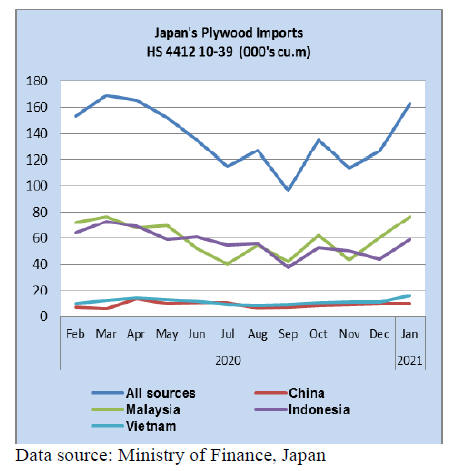

Trade news from the Japan Lumber Reports (JLR)
The Japan Lumber Reports (JLR), a subscription trade
journal published every two weeks in English, is
generously allowing the ITTO Tropical Timber Market
Report to reproduce news on the Japanese market
precisely as it appears in the JLR.
For the JLR report please see:
https://jfpj.jp/japan_lumber_reports/
Forecast of housing starts in 2021
The Japan Forest Products Journal sent out questionnaires
to 14 major house builders to find out how they see new
housing starts in 2021.
Average number by 14 companies is 805,000 units, 1.3%
less than 2020 with high of 835,000 and low of 774,000.
Majority commented that it is hard to predict market future
as long as COVID-19 epidemic continues but it is apparent
that consumers are seeking new life style and the move is
improving. After all, it seems safe to forecast the same as
last year with foggy future.
Total starts in 2020 are 815,340 units, 9.9% less than
2019. Despite worldwide pandemic of COVID-19 in 2020,
damage to housing market is much less than initially
forecasted with 20-30 % drop from 2019.
According to the replies from 14 companies, 2021¡¯s starts
of owner¡¯s units would be 268,500, 0.1% less than 2020.
Rental units would be 298,115, 2.8% less and units built
for sale would be 242,500, 0.9% more. In this,
condominiums would be 106,750, 1.1% less and unit built
for sale of detached units would be 133,625, 2.2% more.
Builders of unit built for sale are bullish since the business
in 2020 was good while builders of owner¡¯s units or
custom made house builders experienced slower sales after
the state of emergency was declared in April in 2020.
Builders of unit built for sale had 20-30% more orders
after May last year, which was unexpected so they need to
keep buying properties.
Builders of owners unit forecast high of 270,000 and low
of 250,000 with average of 258,500 so they think that the
starts would not be as bad as 2020. Rental units are high of
319,000 and low of 270,000 with average of 298,115.
Daito Construction is major builder of rental units and its
forecast is the lowest of 270,000, 12% less than 2020.
Daito¡¯s share of rental units is 16% and share of wooden
rental unit is 40% so Daito¡¯s forecast may be more
realistic
After COVID-19 spread, consumers¡¯ mentality has
changed. Working style is changing with remote tele work
so people are seeking place to live in suburban areas rather
than city center to avoid congested commuting traffic.
Younger people want to have working space at home so
desired management of rooms is changing.
Non-residential wooden buildings in 2020
Total floor space of non-residential wooden buildings in
2020 is 4,341,000 square meters, 11.4% less than 2019.
In 2020, Covid-19 pandemic restrained construction works
and many plans are either postponed or revised.
Also higher construction cost was expected due to the
Tokyo Olympic Games in summer of 2020, which reduced
total construction works.
Non-residential wooden buildings are 1,830,000 square
meters of offices, 2.5% less than 2019, 693,000 square
meters of stores, 22.8% less, 547,000 square meters of
factory, 12.1 % less, 848,000 square meters of warehouse,
0.4% more, 330,000 square meters of school, 17.6% more
and 696,000 square meters of hospital and clinics, 2.4%
more.
South Sea (tropical) logs and lumber
Demand for South Sea hardwood logs is stagnating as
number of log users continue to decline and even
remaining mills shift to other species or veneer instead of
logs so log import volume will drop further this year.
Chinese made laminated free board prices remain high
because high cost of Russian red pine lumber and ocean
freight and temporary shutdown of mills due to COVID-
19 so the manufacturers have no room to drop the prices.
Also Indonesian mercusii pine lumber prices are going up
by log supply shortage and container shortage. Indonesian
suppliers see that Japan accept higher prices of Chinese
made products so they propose higher prices.
Japan¡¯s wood products export in 2020
Export of both logs and lumber in 2020 exceeded 2019
and marked record high.
Strong demand by China for logs and by the U.S.A. for
lumber contributed the increase and the export prices also
climbed. According to the statistics the Ministry of
Agriculture, Forestry and Fisheries, export value of forest
products is 38 billion yen, 2.8% more than 2019.
Growth of logs and lumber export is double digit on
volume and value. While export of logs and lumber
increased, export of other products like plywood declined.
The government has been promoting export of forest
products with subsidy. Log export increased by 250,000
cbms and lumber did by 25,000 cbms. Log export to China
was 1,157,000 cbms, 210,000 cbms more than 2019.
China increased purchase of New Zealand radiate pine
logs after it stopped buying Australian logs so New
Zealand export prices increased by nearly 20% in one
year.
Japanese cedar log prices are US$5-10 lower than radiate
pine logs but climbed as New Zealand log prices increase.
Lumber export to China is almost flat with 65,000 cbms
but the export to the U.S.A. increased to 53,000 cbms.
With busy housing market in the U.S.A., demand for
exterior materials is strong and the demand for Japanese
cedar lumber seems to continue.
Vietnamese LVL manufacturer gets JAS
Vietnamese LVL manufacturer, Woodsland (Hanoi,
Vietnam) got JAS certificate on January 29 for LVL for
fixture material. This is the first JAS LVL manufacturer in
Vietnam. It will export for Japan and also markets LVL
for the Japanese industry in Vietnam for housing materials
and core of furniture and building materials.This company
also manufactures plywood, particleboard and pallet
materials.
The plant which acquired JAS certificate is one of eleven
plants Woodland has in province of Tuyen Quang.
This plant manufactures monthly 2,000 cbms of LVL for
fixture, out of which 1,700 cbms are marketed for Japan
and Japanese managing plants in Vietnam. Vietnamese
LVL plants become more competitive after TPP 11
became effective without any duty and in China, many
plants quit as they are not able to cope with tighter control
of environmental restrictions so China is now relying LVL
supply from Vietnam.
|